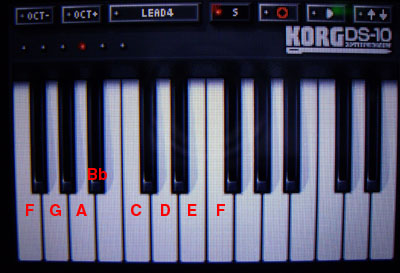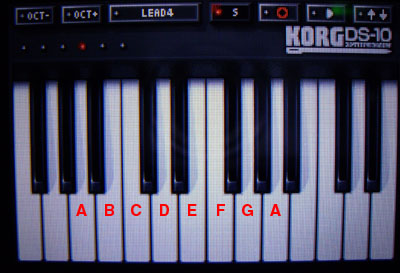A scale is a series of increasing (or decreasing) pitches. The first note in the series is called the root. A scale has 7 pitches and the repeated root, one octave higher.
Let's look at the white keyboard keys, say from C4 (middle C) to C5 (one octave higher). From left to right, the white keys are named C, D, E, F, G, A, B, C. If there is a black key in between two adjacent white keys, it means the interval between the two white keys is a whole step. If there is no black key, the interval is just a half-step. The white keys have two natural half-steps: E-F and B-C. This is fundamental in music theory.
Major Scales
Major scales obey the following progression in terms of intervals:
1 2 3^4 5 6 7^8
The number (1 to 8) is the degree, that is, the position with respect to the root of the scale (the first note). A space between two degrees indicates a whole step and a caret (^) signifies a half-step.
If we look again at the white keyboard keys, starting from C4 (or any other C), the progression:
C D E F G A B C
1 2 3^4 5 6 7^8
is a major scale because we have half-step intervals between keys E-F (degrees 3-4) and B-C (degrees 7-8). This is the C major scale and C is its root (degree 1).

C major scale on the Korg DS-10 keyboard.
The root of a major scale can be any note we wish among the 12 possible pitches. Recall that the sharp accidental ♯ increases the pitch by a half-step while the flat accidental ♭ decreases the pitch by a half-step. For two natural pitches separated by a whole step, the lower note with a sharp accidental is equivalent to the higher note with a flat accidental.
For example, the F major scale would look something like this:
F G A B♭ C D E F
1_2_3^4__5_6_7^8
Because A-B is a whole step and B-C is a natural half step, you need to lower B by a half-step to get the half-step between degrees 3 and 4 and the whole step between degrees 4 and 5.

F major scale on the Korg DS-10 keyboard.
If you play major scales one after the other, they will all sound similar to the C major scale, in terms of progression. Major scales are often described as being joyful (as opposed to minor scales).
Major scales are extremely important to know and understand because intervals between pitches (major, perfect, minor, diminished and augmented) are based on the major scale. Since chords are built using intervals, you can fully measure the importance of those major scales.
Minor Scales
There's only one major scale but several minor scales. We'll focus here on the natural minor scale which is the one to remember.
The natural minor scales obeys the following progression in terms of intervals:
1 2^3 4 5^6 7 8
There is one natural minor scale that can be played with just the white keys: the A natural minor scale. Indeed:
A B C D E F G A
1 2^3 4 5^6 7 8

A natural minor scale on the DS-10 keyboard.
Here is the G natural minor scale:
G A B♭ C D E♭ F G
1_2^3__4_5^6__7_8

G natural minor scale on the DS-10 keyboard.
There is a relationship between major scales and natural minor scales. The sixth degree of a major scale is the root of the relative (associated) minor scale. Similarly, the third degree of a minor scale is the root of the relative (associated) major scale.
If you listen to any natural minor scale, it sounds quite different from a major scale. Minor scales often express sadness (as opposed to major scales).
Keep em comming,
ReplyDeleteVery informative...